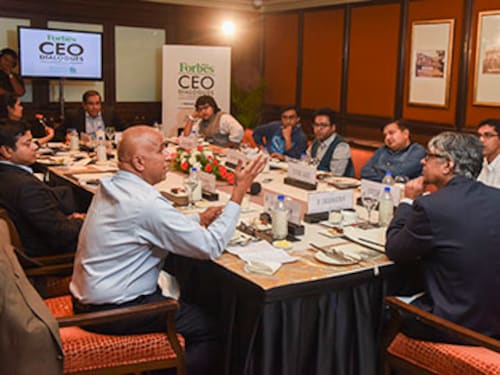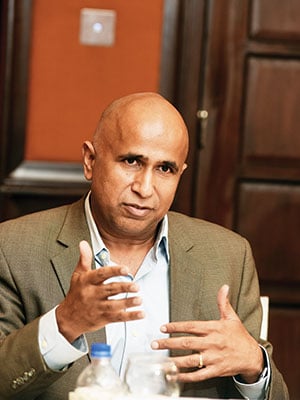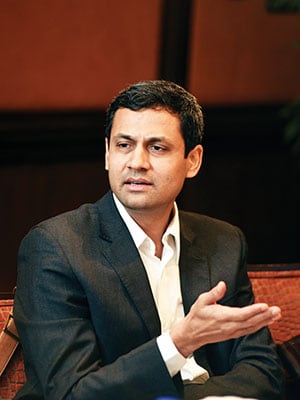For ecommerce, it's growth over profit
Scepticism has given way to optimism and investors are pumping money into the buoyant segment


About a decade ago, global investors were convinced that online retailing won’t work in India. Broadband penetration was dismal, using credit cards was a scary prospect and people hesitated to shop online. The naysayers could not have been more off the mark. Over the last seven years, ecommerce has emerged as a sunshine industry in India with homegrown online retailers like Flipkart and Snapdeal having garnered valuations of several billion dollars. The segment raised the highest quantum of funding from private equity and venture capital investors last year—around $4.1 billion across 106 deals. However, despite the positives, profitability still remains a concern. Companies like Yepme, though, aim to break even this year.
During the ninth edition of the Forbes India CEO Dialogues: The Leadership Agenda, held in Bangalore in January, the country’s top online retailers and investors discussed the challenges facing the segment and the way ahead. They pointed out that clarity on taxes, better infrastructure and increasing usage of internet on handsets will help accelerate growth in the ecommerce industry.
The panellists included Praveen Sinha, co-founder and managing director, Jabong.com Ashish Goel, founder-CEO, Urban Ladder Rahul Chowdhri, partner, Helion Venture Partners Advitiya Sharma, co-founder, Housing.com Vivek Gaur, CEO and co-founder, Yepme.com K Ganesh, serial entrepreneur and promoter-founder of Portea Medical and Sunil Kaushal, regional chief executive, India & South Asia, of Standard Chartered Bank. Edited excerpts from the discussion moderated by R Jagannathan, editor-in-chief, Forbes India:
R Jagannathan: In general, businesses in India may not be having acchhe din, but the ecommerce business is doing well. There seems to be a lot of buzz. Is there too much hype or too little?
K Ganesh: From 2005, people were highly sceptical about ecommerce and raised a lot of questions. Even some top VCs (venture capitalists) in the US, who had invested in India in other sectors, said ecommerce will not work here and that they won’t put their money in the segment. This was the perception in 2005-06, but the reasons cited were wrong. It is because of those very reasons and a nascent market that ecommerce provided a lot of headroom for growth. And that is exactly what has happened in this space. We saw companies such as Flipkart and Snapdeal valued at billions of dollars while global player Amazon is investing $2 billion in India. We have also seen interesting models like Yepme’s, where they created their own brands. In the offline space, it takes a decade to build one’s own brands, but online players have done it in a much shorter time. Even in verticals like jewellery and grocery, online players have created strong brands despite many people saying these won’t work in India because people would like to touch and feel the product that they want to buy. Recently, Tiger Global Management invested in Caratlane.com, and BlueStone.com raised series A and B funding and attracted investments from veterans like industrialist Ratan Tata. We have come a long way from sceptics, who questioned the different online models. Now the question is whether or not the valuations are realistic and justified. Or are they just a bubble? Is the business model sustainable and when will it become profitable? We need to answer these questions now.
Jagannathan: Jabong has been very visible of late and is doing a lot of things. What is Jabong’s priority—is it building sales or going after profitability? How do you balance the two?
Praveen Sinha: It will take 2-3 years before any ecommerce player of a decent size can talk about becoming profitable though I feel it [the timeline] is highly optimistic. There are a few factors involved—one of them boils down to discount coupons. Ecommerce has not reached a stable level where it can become sustainable by itself. So, if the whole margin is 10 percent and the market operates at 15 percent discount, ecommerce companies can never become profitable. In fashion, the margin can be 40-50 percent and, hence, discount coupons can be of a higher denomination. Today, it [profitability] might be achievable, but with huge scale and building an assortment of private labels of higher margin. The next important factor is fulfilment cost where it [the industry] is more or less stable. However, some costs and services such as schedule delivery and same-day delivery will demand a premium which did not exist earlier. We will see ecommerce evolving in that direction and many big players have already started charging for such services. At present, growth is more important than profit. We want to grow in a healthy way.
Jagannathan: Clearly there is no doubt about the potential. Topline is going to grow, but do you feel there are too many similar players within a category who are also marketing themselves similarly? Is there a problem there or, since the size of the pie is so large, it doesn’t matter?
Vivek Gaur: We are creating an asset, whether it is a consumer who is likely to buy again, or a brand which is being developed. However, at Yepme, our model is very different from the others. Even after discount and coupons, we operate at a 48 percent margin because we are only private labels. So, we are [close to] breaking even, even before television advertising. After television advertising, we hope to break even by July-August this year. So the question is, will I stop myself by not putting in another $2-3 million on television advertising because I want to show the bottomline as Ebitda [earnings before interest, taxes, depreciation and amortisation] positive? I don’t think that is the business we are chasing.
Jagannathan: Is there enough differentiation between ecommerce players? Is all of it still driven only by valuation and investments? Is there something more that gives investors far more confidence that this is going to yield dividends in the next three or five years?  Ashish Goel: We are an online furniture brand. I’m biased because we are trying to build a brand and so I have to believe that our product is different from the competition. Though I agree that there has been a lot of euphoria around ecommerce, it’s not been a race to the top it’s sometimes a race to the bottom. I don’t think that the race to the top/bottom mindset is likely to stop anytime soon, especially with capital being more readily and easily available. We are very clearly believers in the power of the products. We invest a lot in design and in defining what the product means. If we don’t spend over 70 percent of our time, effort and mind on the product, two years later nobody is going to remember us. And that holds true for a lot of the sub-categories in ecommerce for sure.
Ashish Goel: We are an online furniture brand. I’m biased because we are trying to build a brand and so I have to believe that our product is different from the competition. Though I agree that there has been a lot of euphoria around ecommerce, it’s not been a race to the top it’s sometimes a race to the bottom. I don’t think that the race to the top/bottom mindset is likely to stop anytime soon, especially with capital being more readily and easily available. We are very clearly believers in the power of the products. We invest a lot in design and in defining what the product means. If we don’t spend over 70 percent of our time, effort and mind on the product, two years later nobody is going to remember us. And that holds true for a lot of the sub-categories in ecommerce for sure.
Jagannathan: The sheer availability of money for ecommerce and related products: Is it a good thing or bad?
Rahul Chowdhri: Overall, I would say it is good. One or two years ago, ecommerce was like a taboo word. If you were an ecommerce company, there was a lot of trouble raising money. Etailing in general is not a very profitable business. So if you don’t have enough cash flow or capital flowing in, you have problems in scaling up. I believe what we have now is better than what we had two years ago. There would always be a situation where there is either over-supply or under-supply, but I would rather stay in a category where there is over-supply and more choice. Now, fundraising has become an important differentiator between two different companies.
Sourav Majumdar (Editor, Forbes India): You say deal-based businesses are probably making way for different kinds of businesses. Are you trying to say that we’ve had deal-based businesses as the basic thrust of ecommerce and now it is time for more grounded businesses?
Chowdhri: Just to differentiate between deal and discount businesses, worldwide there are deal-based businesses such as flash sales that have made huge amounts of money. But I don’t see discounting-based models going away anytime soon. At the same time, there are certain categories where discount is not the only thrust. For example, furniture. I don’t think Urban Ladder is looking for huge discounting.
Jagannathan: Looking at it from a vantage point of a bank, how would you bet on the normal success ratio of the ecommerce players?
Sunil Kaushal: We were reviewing some stressed accounts and there is a very large distributor, who is now shutting down 25-30 percent of his distribution because he has been disrupted by ecommerce players. That’s real pain being felt. At the other end of the spectrum, we have had conversations with manufacturers who say there are certain product categories which they may not put on ecommerce because someone else would give those at discounted rates. So the question is still whether it is really driving a profitable model or not. In today’s scenario, there is little difference between the physical and (for lack of a better word) digital model when it comes to building profitability. Both require sustained investment and a certain timeline for growth. I would say ecommerce is having a real impact. It is the future and at some point there will be a convergence between the physical and ecommerce players. And there will be the growth of a model that would take the best of both.
Jagannathan: What pain points do you see for ecommerce ventures? Gaur: Bandwidth is a challenge and the number one issue for us people have low-end phones which cannot give good user experience. There are 16,000 codes that are still not on cash-on-delivery. India’s postal system is completely broken there, so we are looking overseas now. We believe the next big wave of export could be fashion from India. We have a large manufacturing and textile base and the best skills in designing. The government supporting a brand coming out of India could be a gamechanger for us. For business in India, it’s about broadband and the reach. For business outside India, making the process simpler would be highly helpful.
Gaur: Bandwidth is a challenge and the number one issue for us people have low-end phones which cannot give good user experience. There are 16,000 codes that are still not on cash-on-delivery. India’s postal system is completely broken there, so we are looking overseas now. We believe the next big wave of export could be fashion from India. We have a large manufacturing and textile base and the best skills in designing. The government supporting a brand coming out of India could be a gamechanger for us. For business in India, it’s about broadband and the reach. For business outside India, making the process simpler would be highly helpful.
Advitiya Sharma: The biggest problem that has been plaguing real estate for decades is lack of authentic information. When we started off, we said we have a data collection process through which we will curate all the numbers and showcase authentic information. From an industry point of view, it is important to change the industry from information arbitrage and fake listings to authentic listings to facilitate someone sitting in the US to buy here.
Goel: The challenge is that the tax law is not clear. It is still not clear what the power of the states and Centre are. There are too many rulings. Why would Andhra Pradesh or Telangana start imposing an entry charge on stock transfers into the state? It’s not about whether it’s right or wrong, it’s that it is not clear.
Ganesh: The laws were not designed to handle ecommerce or Uber kind of models… they’re not defined. There are interpretation issues. To give a service, you need the surety of inventory.
Jagannathan: Do you all see yourselves becoming a normal business where there is a proper gap between earnings and expenditure? Currently, it is a potential business. When does it become a real business?
Ganesh: No, it is a real business now. There are tens of thousands of people buying online. You are solving a major pain point and giving access to people in over 5,000 towns and cities, which otherwise they won’t get access to. Someone living in Tripura will see Shah Rukh Khan in a Yepme ad, but there’s no way that you will find that kind of organised retail (premium brands) in small towns in the next 50 years. The amount of transactions that we saw on [Flipkart’s] Big Billion Day… the fact that servers came down shows it’s a real business.
Gaur: ASOS is a business that makes money. Even Boohoo, which is a single brand that got listed in the UK, makes 14-15 percent margins.
So there are enough businesses that have already turned positive, are listed, and public investors are putting in money. But we should not become like the airline businesses, which are completely undifferentiated. The differentiation in ecommerce has started to happen.
Majumdar: How much of this rush is also fuelled by the deep discounts on offer?
Ganesh: Discounts and deals were there earlier too and will continue to be there. In the US, for instance, if you buy a meal, you get a booklet of coupons. It is not just Indian mentality. The discounts being used today are getting people to change their behaviour and accept online businesses. People love the concept of BigBasket but the inertia is there they are not taking the step to move [to online grocery]. Now what is it that will make the person shop online? Call to action, discount... all of this is important. Here, you are trying to change the customer’s buying behaviour. Can you buy big furniture online without going and sitting on the sofa and seeing how it feels? So, things like discount and return policy help.
Jagannathan: Do you think that the investment phase will continue indefinitely? Will it be investing for scale and not necessarily for bottom line? Chowdhri: I would more or less agree. But I think people will start looking for some leverage. Things like, ‘Do we make enough gross margin?’ ‘What percentage of sales is marketing spends?’ And so on… all these things will become important. I think in Yepme’s case, it thinks about gross margins very carefully because it is a brand. A brand cannot be built based on negative gross margins.
Chowdhri: I would more or less agree. But I think people will start looking for some leverage. Things like, ‘Do we make enough gross margin?’ ‘What percentage of sales is marketing spends?’ And so on… all these things will become important. I think in Yepme’s case, it thinks about gross margins very carefully because it is a brand. A brand cannot be built based on negative gross margins.
Jagannathan: Will consolidation accelerate or wait till businesses reach some scale?
Chowdhri: There is consolidation in companies that cannot continue with their business. That will keep on happening because most of these verticals are the same… so, you cannot have three grocery chains online. People will remember only one name. And consolidation of the kind of Myntra getting acquired by Flipkart will take a few more years.
All category leaders are still scaling up.
Gaur: Consolidation will happen if there are common investors on both sides or if some company is dying... so it will be more out of that compulsion. It’s too much of a starting point now (in ecommerce).
First Published: Mar 19, 2015, 06:19
Subscribe Now